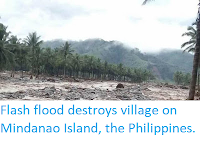The Philippine Institute of Volcanology and Seismology has ordered an evacuation of villages within 6 km of Mount Mayon, a 2463 m stratovolcano (cone shaped volcano) on southern Luzon Island, following an eruption on Saturday 13 January 2018. The eruption, which is thought to be phraetic in origin (i.e. caused by water inside the volcano coming into contact with hot magma then explosively turning to steam) produced an ash column 2.5-3.0 km high, and is the first eruption on Mount Mayon since 2014.
Ash column over Mount Mayon on 13 January 2018. Niño Luces/Manila Bulletin.
Mayon is considered to be a particularly due to the dense population in
the area surrounding it. It has a long history of causing fatalities,
most recently in 7 May 2013, when a sudden eruption caught a party of
tourists by surprise, leading to five fatalities. As well as the direct
danger from volcanic eruptions, Mayon has been the cause of numerous
lahars (ash-laden flash foods). These tend to occur when ash from the
volcano builds up across the path of seasonal waterways during the dry
season, leading to temporary damming of water courses then flash floods
at the start of the rainy season.
The location of Mount Mayon. Google Maps.
The geology of the Philippines is complex, with the majority of the islands located on the east of the Sunda Plate. To the east of this lies the Philippine Sea plate, which is being subducted beneath the Sunda Plate (a breakaway part of the Eurasian Plate); further east, in the Mariana Islands, the Pacific Plate is being subducted beneath the Philippine Sea Plate. This is not a smooth process, and the rocks of the tectonic plates frequently stick together before eventually being broken apart by the rising pressure, leading to Earthquakes in the process. Material from the subducting Philippine Plate is heated by the temperature of the Earth's interior, causing lighter minerals to melt and the resultant magma to rise through the overlying Sunda Plate, fuelling the volcanoes of the Philippines.
Subduction beneath the Philippines. Yves Descatoire/Singapore Earth Observatory.
See also....
Follow Sciency Thoughts on Facebook.









